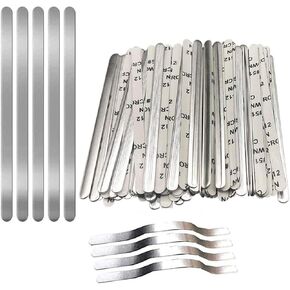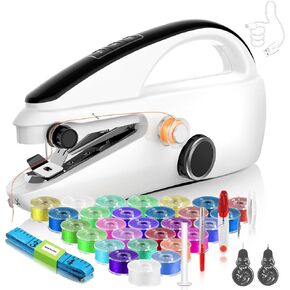- Shopping, made easy.
- /
- Get the app!
Threading Instructions
Prepare the Thread Spool:
Place the thread spool on the spool pin at the top of the machine. Ensure the spool rotates freely.
If your machine has a horizontal spool pin, secure the spool with a spool cap to prevent it from slipping.
Guide the Thread:
Pull the thread from the spool and guide it through the thread guide(s) at the top of the machine. This step ensures the thread follows the correct path.
Follow the numbered threading path indicated on your machine. Most machines have arrows or numbers to guide you.
Thread the Tension Discs:
Pass the thread through the tension discs. This step is critical for maintaining proper thread tension during sewing.
Ensure the thread is securely seated between the discs to avoid loose stitches or thread breaks.
Thread the Take-Up Lever:
Pull the thread down and pass it through the take-up lever. This lever moves up and down with the needle and helps regulate the thread flow.
Make sure the thread is securely looped through the take-up lever to prevent it from slipping out.
Thread the Needle:
Pass the thread through the needle from front to back. Use a needle threader if necessary, especially for small needle eyes.
Pull about 5-6 inches of thread through the needle to ensure enough thread for starting your stitch.
Draw Up the Bobbin Thread:
Hold the needle thread lightly and turn the handwheel toward you to lower and then raise the needle. This action will catch the bobbin thread and bring it up through the needle plate.
Pull both threads (needle and bobbin) under the presser foot and toward the back of the machine.
Fabric Compatibility
To achieve the best sewing results, it's important to use the correct needle and thread for your fabric type.
Here's a quick guide:
Lightweight Fabrics (e.g., Chiffon, Silk, Organza):
Needle: Use a fine needle (size 60/8 or 70/10).
Thread: Opt for lightweight polyester or cotton thread.
Tips: Use a smaller stitch length (1.5-2 mm) to prevent puckering.
Medium-Weight Fabrics (e.g., Cotton, Linen, Polyester):
Needle: A universal needle (size 80/12) works well for most medium-weight fabrics.
Thread: All-purpose polyester or cotton thread is ideal.
Tips: Adjust the stitch length to 2.5 mm for balanced stitches.
Heavyweight Fabrics (e.g., Denim, Canvas, Upholstery Fabric):
Needle: Use a heavy-duty needle (size 90/14 or 100/16).
Thread: Heavy-duty polyester or bonded nylon thread is recommended.
Tips: Increase the stitch length to 3-4 mm for stronger seams.
Stretch Fabrics (e.g., Jersey, Spandex, Lycra):
Needle: A ballpoint or stretch needle (size 75/11 or 90/14) is best for stretch fabrics.
Thread: Use polyester thread with some elasticity.
Tips: Use a narrow zigzag stitch to allow the seam to stretch with the fabric.
Additional Tips for Optimal Performance
Thread Tension Adjustment: If your stitches are too tight or too loose, adjust the thread tension dial. Refer to the user manual for specific instructions.
Fabric Placement: Always place the fabric under the presser foot before lowering it. Ensure the fabric is flat and smooth to avoid uneven stitches.
Maintenance: Regularly clean the bobbin area and oil the machine as recommended in the user manual to prevent thread breaks and ensure smooth operation.
 -18%
FoamRush 2" x 24" x 72" High Density Upholstery Foam Cushion (Seat Replacement, Upholstery Sheet, Foam Padding) Made in USA
KWD 13.500
-18%
FoamRush 2" x 24" x 72" High Density Upholstery Foam Cushion (Seat Replacement, Upholstery Sheet, Foam Padding) Made in USA
KWD 13.500
 Iron On Star Patches Embroidered Patch Applique Embellishments for Clothing, Jackets, Backpacks, and Decorations (Red, 1")
KWD 4
Iron On Star Patches Embroidered Patch Applique Embellishments for Clothing, Jackets, Backpacks, and Decorations (Red, 1")
KWD 4
 Nose Bridge Strips for Masks, Aluminum Metal Nose Strip, Adjustable Nose Clips Wire for DIY Mask Making Accessories for Sewing Crafts, 100Pcs
KWD 3
Nose Bridge Strips for Masks, Aluminum Metal Nose Strip, Adjustable Nose Clips Wire for DIY Mask Making Accessories for Sewing Crafts, 100Pcs
KWD 3
 37PCS Accessories Handheld Sewing Machine, Rechargeable Mini Sewing Machine for Beginners and Adults, 2 Modes Portable Sewing Machine Handheld Easy to Use and Fast Stitch Suitable for DIY, Clothes
KWD 15
37PCS Accessories Handheld Sewing Machine, Rechargeable Mini Sewing Machine for Beginners and Adults, 2 Modes Portable Sewing Machine Handheld Easy to Use and Fast Stitch Suitable for DIY, Clothes
KWD 15